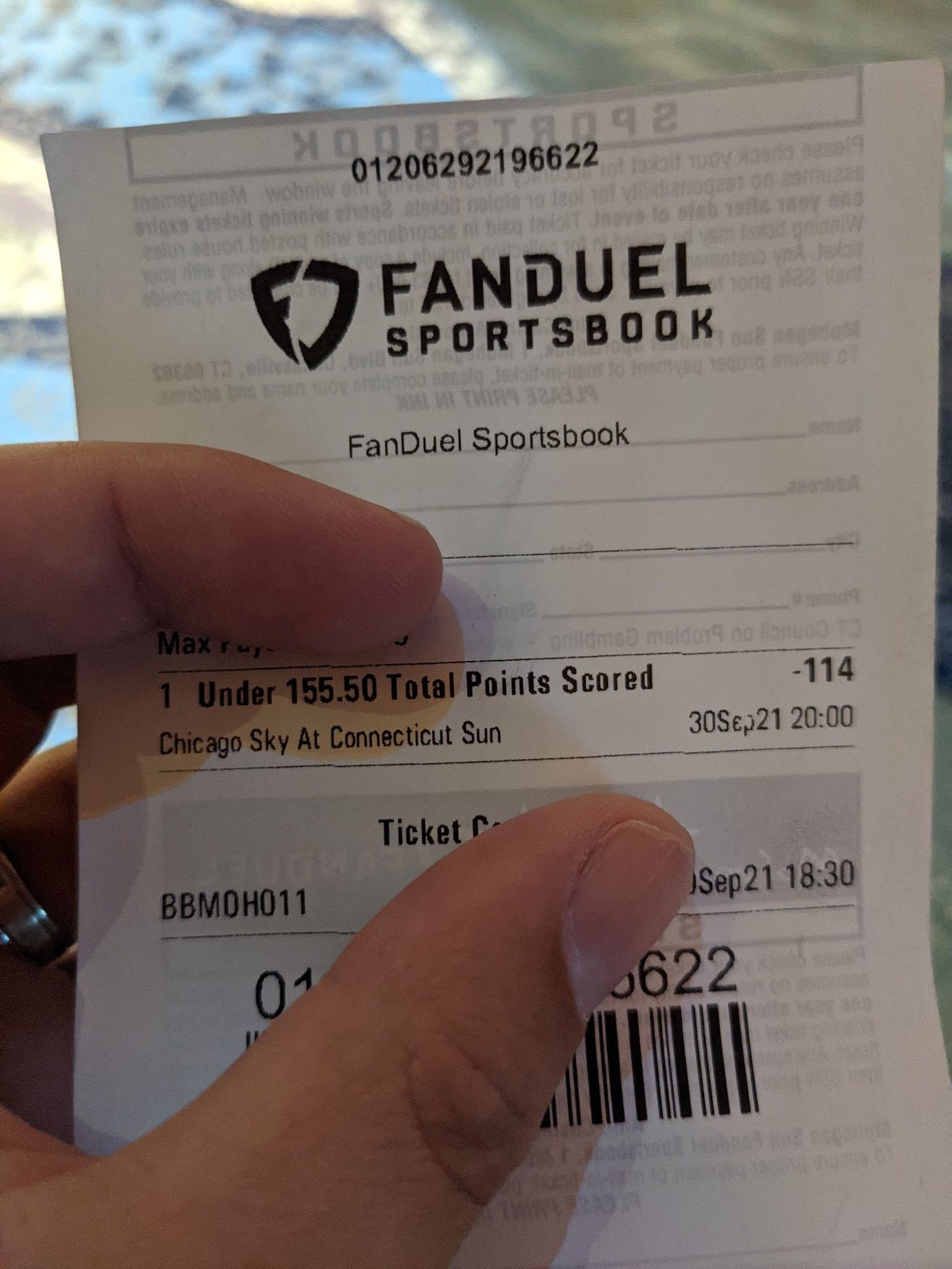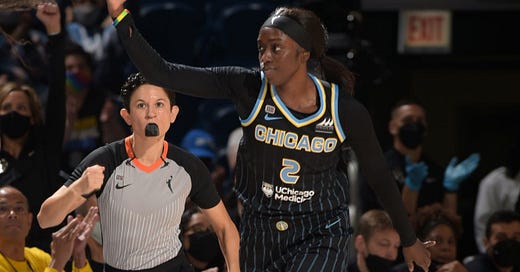The Weekly Roundup: Inside the Captivating Sun-Sky Series and My Experience with Sports Betting
Assessing which stats have been the most meaningful in the battle between Connecticut and Chicago
Thanks for reading the Her Hoop Stats Newsletter. If you like our work, be sure to check out our stats site, our podcast, and our social media accounts on Twitter, Facebook, and Instagram. You can also buy Her Hoop Stats gear, such as laptop stickers, mugs, and shirts!
Haven’t subscribed to the Her Hoop Stats Newsletter yet?

Up is down; left is right, and the No. 5 and No. 6 seeds are one win away from the WNBA Finals.
Diana Taurasi, she of “Why can’t old people dream too?” fame, exploded for a playoff career-high 37 points (on just 13 field goal attempts!) in Game 2. The GOAT spearheaded a potent Phoenix offense, whose 117 points missed the single-game points record by just three. Brianna Turner’s monster 23-point, 17-rebound performance in Game 3 led the Mercury to an 87-60 thrashing of Las Vegas and a 2-1 lead in the best-of-five series.
In a series that I wish the WNBA would extend to a best-of-seven, Kahleah Copper’s 26-point effort in Chicago’s 86-83 Game 3 win has put nearly everyone’s championship pick, the Connecticut Sun, on the brink of elimination. A series that has featured a double-overtime game, the second-ever playoff triple-double, and the resurgence of Alyssa Thomas warrants a closer look. So, let’s examine the first three games of this phenomenal series through the prism of the three most meaningful statistics in each contest.
Three game-defining stats - Chicago vs. Connecticut
Game 1: Pace
With 77.6 possessions per 40 minutes, the Connecticut Sun ranked last in pace during the regular season. As Myles Ehrlich of Winsidr explained, this methodical game plan reduced the potential for injuries and preserved players’ energy. After all, four of the Sun’s five starters averaged more than 30 minutes per game (Connecticut’s fifth starter, Jasmine Thomas, finished the season just 13 total minutes shy of this mark). No other team in the W had more than three starters hit this threshold.
Averaging 5.1 more possessions per 40 minutes than the Sun, the Chicago Sky finished third in pace out of 12 teams. During the regular season, they forced the Sun into two of their three fastest-paced games (both Sun losses). So, it wasn’t exactly a state secret that the ability to dictate tempo would play a key role in this semifinal series. In their pregame comments, each coach recognized the importance of pace to their team’s success.
“Their pace is incredible both on misses and makes,“ Connecticut coach Curt Miller explained. “We have to have a good night in transition defense. How we can help ourselves is with offensive execution.”
“It’s important because Connecticut wants to slow it down,” Chicago coach James Wade commented. “They play very methodical, and defensively they want you to be stuck on one side of the floor. And they want to close the paint, so we just have to move them as much as possible.”
Chicago established its desired tempo in the early going of its Game 1 double-overtime victory last Tuesday. Despite five first-quarter turnovers, the Sky dropped 24 points on 19 field goal attempts, well above the 16.3 points and 15.8 field goal attempts Sun opponents averaged in the first quarter this season. So, what was the pace in Game 1 last Tuesday? 80.4. Connecticut has played just five faster-paced games this season. Chicago’s struggles controlling the defensive glass - grabbing less than 70% of defensive rebounding chances for only the 11th time all season - and forcing turnovers reduced its fast-break opportunities. However, the Sky still managed to create an offensive flow that flummoxed an ordinarily stingy Sun defense into its eighth-worst defensive rating of the season. Speaking of defensive rebounding...
Game 2: Chicago’s defensive rebounding rate
When asked by announcers Ryan Ruocco and Rebecca Lobo about the keys to the series, Courtney Vandersloot stated that she truly believed rebounding would be the difference. That take proved prescient in Game 2 last Thursday.
Chicago’s subpar effort on the defensive glass in Game 1 was overshadowed by the team’s ability to control tempo and its shotmaking, knocking down 49.4% of field goals (comfortably north of its 44.1% season average). The Sky’s explosive 11-0 run to open Game 2 indicated that history might repeat itself. Unfortunately for fans from the Windy City, that didn’t happen. Chicago hit only 39.7% of its field goals plus the team’s rebounding woes persisted. The Sky grabbed 62.5% of their defensive rebound opportunities, their fourth-worst performance on the defensive glass this season. Led by Alyssa Thomas, Connecticut outpaced Chicago 19-9 in second-chance points. Connecticut scored 10 second-chance points in the fourth quarter alone (Chicago had zero), transforming a one-point deficit into an 11-point win.
Game 3: Zero field goal attempts for Jonquel Jones and five Sun turnovers in the final 6:27
These are too interrelated to select just one. She’s the MVP. She’s the Sun’s best offensive option, and yet Jonquel Jones failed to attempt a shot (field goal or free throw) during the final 6:27 of a playoff game. That’s inexcusable.
A major reason for this lack of production down the stretch was Chicago’s defense, which forced the Sun into five turnovers during a 15-2 Sky run that took place during the aforementioned 6:27 stretch. It’s clear that in Game 2 and for much of Game 3, the physicality of Chicago’s defense threw off Jones’ offensive rhythm. Kudos to Azura Stevens for her defensive efforts during this timeframe (and frankly, all series long) limiting Jonquel Jones’ opportunities. Holding this year’s MVP to 14 points across 60 minutes of action is no small feat.
On the flip side, the Sun need more of the Jonquel Jones who bullied her way to six first-quarter points Sunday afternoon and less of the star player who disappeared during crunch time in Game 3. Jones must counter Chicago’s defensive physicality with her own offensive aggression, particularly in the closing minutes of a playoff game. Are a wild layup and an off-balance 15-foot jumper by Alyssa Thomas really the ideal final two possessions for Connecticut? Put the game in the hands of the best player in the league and allow her to create, just as she has done all season.
You’ve gotta know when to hold ‘em, know when to fold ‘em
It’s been bittersweet tracking the gambling wisdom imparted by our own Calvin Wetzel and Debbie Antonelli this season. Whether it be Calvin’s Wetz Betz or his and Debbie’s WNBA Betting Show on YouTube (shoutout to producer Gabe Ibrahim), it’s been fascinating to learn about the basics of sports betting (e.g., the types of bets, different strategies such as taking the under on back-to-back games, etc.). Unfortunately, sports betting has not yet made its way to Massachusetts. So, as a resident of the Bay State, I was on the outside looking in.
That all changed last Thursday when my wife and I traveled to Mohegan Sun Arena for Game 2 of the WNBA semifinals. Already thrilled about attending the night’s playoff game, we then learned that sports betting had become legal in Connecticut that very day. So, we hustled over to Mohegan Sun a couple of hours before game time, and like kids on Christmas morning, sprinted over to the sports betting kiosks and made wagers on both of the night’s semifinal contests.
The game itself was amazing, a nip-and-tuck affair until Alyssa Thomas helped the Sun avoid a disastrous 0-2 hole and exploded for 10 points and five boards in the fourth quarter alone. However, my wager on the game (betting that the Sun and Sky would combine for fewer than 155.5 points) provided an extra layer of excitement, making the experience that much more entertaining. That’s part of the genius of sports betting. It provides additional intrigue to already interesting games and keeps fans invested in games that are, say, less captivating. While there are certain to be a few bumps in the road along the way (as the recent suspension of WNBA betting at Mohegan Sun demonstrated), sports betting could be an important engine to the WNBA’s growth.

Following a Connecticut Sun playoff victory and my gambling win, I was on cloud nine. My foray into the sports betting world was a success and an absolute blast! Let’s just not talk about my under bet on that evening’s Aces/Mercury game.
Defense Doesn’t Win Championships?
With all due respect to the people in those Progressive advertisements who fear becoming their parents, defense might not win championships. At least, Chicago coach James Wade doesn’t hope so. After all, his team is facing a historically great defense in the Connecticut Sun.
James Kay of Winsidr recently asked Wade what makes Connecticut so effective defensively, comparable to the 2007 Indiana Fever. After giving his response, Wade coyly asked how that Indiana team fared in the postseason. Kay replied that he didn’t know off the top of his head, to which Wade deadpanned, “Find out and let me know.”
Indiana lost in the semifinals that year to Detroit.
WNBA schedule this week (All times Eastern)
Here is a listing of this week’s playoff games, start times, and where you can catch the action. If both semifinal series end in four games, Games 1 and 2 of the WNBA Finals will take place on Friday and Sunday, respectively.
Her Hoop Stats content in case you missed it
It’s another double dose of Courtside! In the first episode, Gabe Ibrahim and Christy Winters-Scott discussed what the future holds for the four franchises that recently saw their seasons come to an end in the playoffs. In the latest episode (Courtside’s 50th!), Gabe and Christy talked about the two semifinal series and what the Sun and Aces must do to force a decisive fifth game.
After just 12 games in last season’s WNBA bubble, Brittney Griner left the Phoenix Mercury for undisclosed personal reasons and didn’t play competitive basketball until joining her Russian team, UMMC Ekaterinburg, in January. Kim Doss described the importance of this break to Griner’s mental well-being and to her dominance this season.
The WNBA awarded its end-of-season honors last week; however, Richard Cohen still has a few pieces of hardware to hand out. Who took home the prestigious Bargain of the Year accolade? Which player captured the equally impressive About Damn Time prize? Richard has the answers in the latest installment of WNBA Dissected.
Other recommended content
Zachary Huber of The Independent Florida Alligator detailed the toxic atmosphere in the University of Florida basketball program under former coach Cam Newbauer.
As part of SLAM’s series spotlighting Black coaches at different levels, Charlie Desadier chronicled Tanisha Wright’s path to becoming an assistant coach with the Las Vegas Aces.
Chantel Jennings of The Athletic explored the travel difficulties experienced by WNBA teams and offered potential solutions to this recurring problem.
Jane McManus of Deadspin explained why the WNBA is in a strong enough position to survive if Sue Bird retires after this season.
In the latest installment of her “Family Rivalries” series for The Next, Jenn Hatfield explored the compelling basketball journeys of Shoni, Jude, and Milan Schimmel.
WNBA trivia question of the week
Name the four players in WNBA history who have won an Olympic gold medal and a WNBA title in the same calendar year.
Thanks for reading the Her Hoop Stats Newsletter. If you like our work, be sure to check out our stats site, our podcast, and our social media accounts on Twitter, Facebook, and Instagram.




